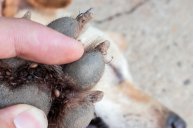Whether you take your pup hiking on trails, hunting through fields, or exploring in the backcountry, if your dog spends any time outside, they're prone to picking up ticks—which means you need to know how to remove a tick from your dog, safely.
These pesky parasites can carry a host of dangerous diseases that come with serious symptoms. From Lyme disease to Rocky Mountain spotted fever to babesiosis, tick-borne diseases pose risk for joint pain, gastrointestinal distress, neurological issues, organ damage, paralysis, and even death.
In addition to the pet health risk tick-borne illness can pose, if a tick latches onto your dog's fur it can hitch a ride into your home and end up biting you or your human family members and set off a whole new set of disease risks.
Tick Prevention

Getty Images, Dmitrii Anikin
The best way to avoid tick-borne diseases (and to avoid having to remove one from your dog) is to prevent the pests from latching onto your pup in the first place.
Tick collars, chewables, topicals—a wide variety of tick prevention products are available, both over the counter and from your veterinarian. Animals can be sensitive to some of these treatments so it's always smart to talk to a vet about which option is right for your dog first.
When to Check Your Dog For Ticks

Getty Images, Bogdan Kurylo
Even with all the precautions in place, ticks can easily make their way onto your pup anytime they're outside. Their risk for ticks is highest in the spring, summer, and fall, but in some parts of the country, ticks are ready to latch onto you and your pup year-round. That's why the CDC recommends examining dogs daily for ticks.
This is especially important any time they come in from outside, as the American Kennel Club reports that tick-borne diseases can be transmitted within 3-6 hours of a bite.
How to Remove a Tick From a Dog

Getty Images, kamontad123
- Don't Try DIY Methods. The veterinarians at Banfield Pet Hospital say that despite the DIY tick removal tips you might have heard, you should not use nail polish, Vaseline, rubbing alcohol, matches, or gasoline on a tick bite. These methods don't work and could actually hurt your pup.
- Carefully inspect every inch of your dog. Check from head to tail with a pair of fine-point tweezers in hand (dental floss, the edge of a credit card, or a specialized dog tick-removing tool can work too). Look for small dark spots, ranging from the size of a pen point to around a half-inch long as different tick species can vary in size and appearance.
- Double check certain spots. According to Banfield's experts, some of the top spots ticks hide on your dog's body include in and around the ears, near the eyes, under a collar, between the legs, along the tail, and between toes.
- If you find a tick, grab the tweezers. Your goal here is to pull the tick off your dog in one piece to prevent infection or irritation. Don't use your bare hands, as this can cause more risk to you and force more bacteria into your pup. Using a pair of tweezers, grab the tick's head — not the tick's body, which may be engorged. In one smooth, steady motion, slowly pull the tick off.
- If the tick breaks, don't panic. If parts of the tick—usually the head or mouthparts—are still in your dog's skin, don't start digging for them which could cause irritation. These pieces typically work to the surface over time. Gently disinfect the area with soap and water.
- Save the specimen. Resist the urge to squish or flush the tick. Instead, you should place it in a secure bag or jar so it can be tested for diseases if your dog begins to show symptoms.
- Keep an eye on your pooch. The tick could cause health problems for your pooch, either from a disease it was carrying or from an infection at the bite site. According to Banfield Pet Hospital, you should call a vet if your dog exhibits limping, fatigue, fever, or other signs of a problem. Also give your vet a call if you're concerned about infection from pieces of a tick left behind in your pet's skin, or you simply want to play it safe.
NEXT: UV SUNGLASSES FOR DOGS: 8 OPTIONS TO PROTECT YOUR POOCH'S PEEPERS




